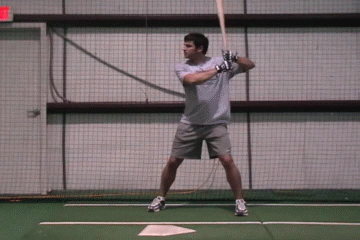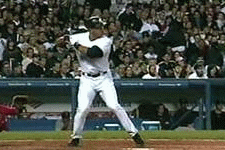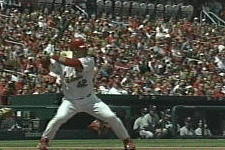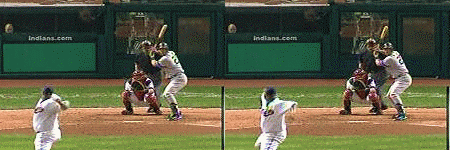Well....it clearly isn't this....

This hitter suffers from both hip slide and barrel slide.
And both come about from a 'need'......a need to 'get going'....a need to break inertia.
I see little to no resistance being used. You could say his lead leg block provides resistance.....but that is WAY late....and not nearly explosive enough. It is slow developing....and offers no mechanical advantage. It requires an amount of forward movement not seen in most high level hitters.
Something rarely talked about....although Hiddengem and I have spoken about it on a couple of occasions.....is the 'invisible' work. The work that takes place before movement is seen. The lag time between the mind sending the signal until movement is seen.
There is a neurological lag....the time it takes the signal to cause action. And there is a muscle contaction lag....the time it takes the muscles to break inertia before the bones actually move.
How long is this lag?
How do hitters deal with it?
Are their substitutes?
Is there an 'invisible' running start?
Well, as a starting point....think of pushing a car. Great effort must be given to move a car. But, it can be done. And, a great effort is given LONG before the car moves. I'm not a scientist....but I believe that is called breaking inertia. All scientists speak up and correct this at any time you see fit.
Something similar happens in hitting. While the 'load' weighs far less....only about two pounds....there are time restraints that make it important to move this two pound object quickly. Normally there aren't time restraints on when the car moves. You can position yourself.....to gain leverage.....and push and push and push.....and it will move.....when you push enough to break the inertia. It will happen....you want it to happen sooner than later....but once it starts to move....it is pretty simple to keep it moving assuming you dont' face a hill or an object. But....there was quite a length of time where 'work' was being done before the bones of the pusher moved.
Hitting has a two pound object that must be moved....and moved suddenly. And, there is somewhat of a directional issue....meaning the object has to be directed to a specific spot....where it will intersect the ball.
My brain, operating from a 'feel' perspective, tells me that if you use forward momentum as your inertia breaker....whether that be with the hands/arms....'down through the nipple'....or with the lower body....'straightline push'.....you are compromising your ability to square bat and ball.
IMO, what is taking place in the high level pattern, is a process of using resistance....to create an 'inertia lag'.....a time where energy is actually being applied....muscles are actually contracting....without bone movement.....that allows an invisible running start....before the visible running start.....and that allows a 'start' without a 'go'.....which is instrumental in getting the two engines to align....to sync.....that then leads to a sudden unleashing of the bat.
I've used this silly analogy before....but loading the forefinger against the thumb to shoot a marble across the floor....creates a far superior result than just pushing with the forefinger without a thumb load. The finger starts early....and is held up....by the resistance of the thumb.....an invisible running start....that no one would question exists. And when the thumb 'gives'....the forefinger fires forward with great force.
The coil of the lower body......which is a rotational move.....a 'negative' rotational move.....a load.....which is usually accompanied by an inward turn of the lead knee......is the 'thumb'...against which the push of the rear hip and leg (the forefinger) occurs. This occurs on/over one leg. The lead leg is either off the ground or unweighted. Which is an important aspect to how and where the resistance is felt......in the rear hip pivot point. IF the lead leg is weighted.....you won't have a rear hip pivot point. The lead leg with be 'in the way'....and it will compromise your ability to unload in the direction it needs to be unloaded. This push is of the rear hip and leg is not a straighline push. This push is a rotational push.....in that it is a combined move of the rear leg and hip......a hip thrust type action.....centered in the rear hip joint....which creates the rear hip pivot point. The leg's push is not forward as much as it is upward.....upward into the hip socket.....upward without corresponding bone movement upward.....unless the pitch calls for it. The upward push also occurs against the 'sit'.....more resistance.....of the pelvis on the ball of the femur. The 'action' of the lower body is completely in the rear hip. By that I mean the goal, the signal, is to move the rear hip around the ball of the femur with a directional component which is pitch dependent. And, I guess a main purpose of this post....is to explain that there is rotation going on before it is visible. The lower body unloads completely rotationally.....it unloads with rotation in the rear hip....as the rear leg pushes upward....while the lead foot is off the ground and/or unweighted.....and it is this unload that shifts the weight. Any shift of weight before this unload of the rear hip.....compromises power and quickness.
One-legged hitting.
If one agrees that the lower body loads with coil....then you must believe that the unload is uncoil.....not a straightline push. Why would you coil to just bleed it open with a straightline push. That makes no sense. You load so as to unload. Your load is the reverse action of your unload. Your unload is NOT an action different from your load.
Here are several clips of Bonds. In some, the hip 'up and through' is obvious. In some, it is not. I maintain the rear hip and leg 'action' is the same in all the clips.....it is a rotational unload of the rear hip pivot point.....which started with resistance.....with an 'invisible running start'.....which is metered into a visible running start....which leads to the sudden unload.....and then and only then....after the swing launch....does the lead leg block come into play.
Bonds
So.....back to the title of the thread....."What Is Staying Back"
Staying back is the invisible running start. Staying back is the thumb load. It is not just standing there waiting to do something.....even though no movement may be taking place. Important stuff is being done without being 'seen'.
Moving forward with unrestricted linear momentum, no resistance, like in Macias, IMO, doesn't happen in the high level swing. I believe what you see is really a rotational unload.....that can't be seen....because the bones aren't moving yet.....because of the resistance the hitter has created.
Some of you have posted a clip of Arod....or Pujols....to counter my belief that the rear hip/leg unload is completely rotational. You have shown their heads moving forward. That is hard to deny. And I don't have an explanation for why two great hitters do something different than the rest....


But.....I do want to point out that both of their lead knees are counterrotated more so than many other hitters.....and this provides greater resistance for them to start the 'invisible running start' against. And they allow some forward momentum to take place, while maintaining this resistance. I maintain that forward momentum is part of their rotational unload.....meaning the action in the rear hip....is rotational....but the resistance of the lead knee keeps it from happening....and forward momentum results. And when that lead knee 'gives'....there is sudden rotation....much more sudden than would occur if the 'invisible running start' was linear. What they are doing is much like pitchers do. Even though they drift forward more than the others.....they maintain that lead knee resistance.....which allows them to maintain the rear hip load.....and to launch the swing as 'one move'.
And this use of resistance.....allowing both the invisible running start.....and the visible running start.....is how hitters not only unload so suddenly.....but it is how they learn to adjust to pitch speeds.

This hitter suffers from both hip slide and barrel slide.
And both come about from a 'need'......a need to 'get going'....a need to break inertia.
I see little to no resistance being used. You could say his lead leg block provides resistance.....but that is WAY late....and not nearly explosive enough. It is slow developing....and offers no mechanical advantage. It requires an amount of forward movement not seen in most high level hitters.
Something rarely talked about....although Hiddengem and I have spoken about it on a couple of occasions.....is the 'invisible' work. The work that takes place before movement is seen. The lag time between the mind sending the signal until movement is seen.
There is a neurological lag....the time it takes the signal to cause action. And there is a muscle contaction lag....the time it takes the muscles to break inertia before the bones actually move.
How long is this lag?
How do hitters deal with it?
Are their substitutes?
Is there an 'invisible' running start?
Well, as a starting point....think of pushing a car. Great effort must be given to move a car. But, it can be done. And, a great effort is given LONG before the car moves. I'm not a scientist....but I believe that is called breaking inertia. All scientists speak up and correct this at any time you see fit.
Something similar happens in hitting. While the 'load' weighs far less....only about two pounds....there are time restraints that make it important to move this two pound object quickly. Normally there aren't time restraints on when the car moves. You can position yourself.....to gain leverage.....and push and push and push.....and it will move.....when you push enough to break the inertia. It will happen....you want it to happen sooner than later....but once it starts to move....it is pretty simple to keep it moving assuming you dont' face a hill or an object. But....there was quite a length of time where 'work' was being done before the bones of the pusher moved.
Hitting has a two pound object that must be moved....and moved suddenly. And, there is somewhat of a directional issue....meaning the object has to be directed to a specific spot....where it will intersect the ball.
My brain, operating from a 'feel' perspective, tells me that if you use forward momentum as your inertia breaker....whether that be with the hands/arms....'down through the nipple'....or with the lower body....'straightline push'.....you are compromising your ability to square bat and ball.
IMO, what is taking place in the high level pattern, is a process of using resistance....to create an 'inertia lag'.....a time where energy is actually being applied....muscles are actually contracting....without bone movement.....that allows an invisible running start....before the visible running start.....and that allows a 'start' without a 'go'.....which is instrumental in getting the two engines to align....to sync.....that then leads to a sudden unleashing of the bat.
I've used this silly analogy before....but loading the forefinger against the thumb to shoot a marble across the floor....creates a far superior result than just pushing with the forefinger without a thumb load. The finger starts early....and is held up....by the resistance of the thumb.....an invisible running start....that no one would question exists. And when the thumb 'gives'....the forefinger fires forward with great force.
The coil of the lower body......which is a rotational move.....a 'negative' rotational move.....a load.....which is usually accompanied by an inward turn of the lead knee......is the 'thumb'...against which the push of the rear hip and leg (the forefinger) occurs. This occurs on/over one leg. The lead leg is either off the ground or unweighted. Which is an important aspect to how and where the resistance is felt......in the rear hip pivot point. IF the lead leg is weighted.....you won't have a rear hip pivot point. The lead leg with be 'in the way'....and it will compromise your ability to unload in the direction it needs to be unloaded. This push is of the rear hip and leg is not a straighline push. This push is a rotational push.....in that it is a combined move of the rear leg and hip......a hip thrust type action.....centered in the rear hip joint....which creates the rear hip pivot point. The leg's push is not forward as much as it is upward.....upward into the hip socket.....upward without corresponding bone movement upward.....unless the pitch calls for it. The upward push also occurs against the 'sit'.....more resistance.....of the pelvis on the ball of the femur. The 'action' of the lower body is completely in the rear hip. By that I mean the goal, the signal, is to move the rear hip around the ball of the femur with a directional component which is pitch dependent. And, I guess a main purpose of this post....is to explain that there is rotation going on before it is visible. The lower body unloads completely rotationally.....it unloads with rotation in the rear hip....as the rear leg pushes upward....while the lead foot is off the ground and/or unweighted.....and it is this unload that shifts the weight. Any shift of weight before this unload of the rear hip.....compromises power and quickness.
One-legged hitting.
If one agrees that the lower body loads with coil....then you must believe that the unload is uncoil.....not a straightline push. Why would you coil to just bleed it open with a straightline push. That makes no sense. You load so as to unload. Your load is the reverse action of your unload. Your unload is NOT an action different from your load.
Here are several clips of Bonds. In some, the hip 'up and through' is obvious. In some, it is not. I maintain the rear hip and leg 'action' is the same in all the clips.....it is a rotational unload of the rear hip pivot point.....which started with resistance.....with an 'invisible running start'.....which is metered into a visible running start....which leads to the sudden unload.....and then and only then....after the swing launch....does the lead leg block come into play.
Bonds
So.....back to the title of the thread....."What Is Staying Back"
Staying back is the invisible running start. Staying back is the thumb load. It is not just standing there waiting to do something.....even though no movement may be taking place. Important stuff is being done without being 'seen'.
Moving forward with unrestricted linear momentum, no resistance, like in Macias, IMO, doesn't happen in the high level swing. I believe what you see is really a rotational unload.....that can't be seen....because the bones aren't moving yet.....because of the resistance the hitter has created.
Some of you have posted a clip of Arod....or Pujols....to counter my belief that the rear hip/leg unload is completely rotational. You have shown their heads moving forward. That is hard to deny. And I don't have an explanation for why two great hitters do something different than the rest....


But.....I do want to point out that both of their lead knees are counterrotated more so than many other hitters.....and this provides greater resistance for them to start the 'invisible running start' against. And they allow some forward momentum to take place, while maintaining this resistance. I maintain that forward momentum is part of their rotational unload.....meaning the action in the rear hip....is rotational....but the resistance of the lead knee keeps it from happening....and forward momentum results. And when that lead knee 'gives'....there is sudden rotation....much more sudden than would occur if the 'invisible running start' was linear. What they are doing is much like pitchers do. Even though they drift forward more than the others.....they maintain that lead knee resistance.....which allows them to maintain the rear hip load.....and to launch the swing as 'one move'.
And this use of resistance.....allowing both the invisible running start.....and the visible running start.....is how hitters not only unload so suddenly.....but it is how they learn to adjust to pitch speeds.


Comment